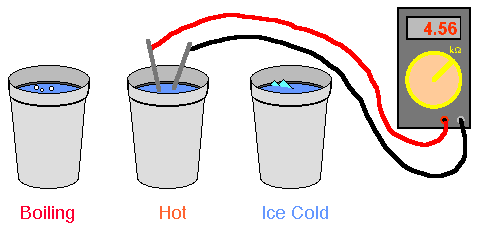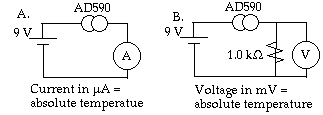 |
Hands-On-Physics
HEAT & TEMPERATURE
|
Messing
Around
|
- Sensors -
|
For this activity you will need sevral sensors: 100 Ohm thermistor, 1N914
diode, thermocouple wire, resistance wire, AD590, LM35 or LM335. You will
also need styrofoam cups, and hot and cold water. (Boiling water and ice
preferred.)
Use your meter to measure the sensor outputs. Measure each sensor when placed
in cups of hot, warm, and cold water. If possible, use ice water and boiling
water because you know they will be near 0 °C and 100 °C. Make
the water in a third cup as close as possible to half-way between your hot
and cold cups.

Figure M2
Measuring Sensor Output
Sensors to Investigate
- Thermistor:
Measure the resistance of the thermistor.
(Set the multimeter scale to K Ohms and connect the two
leads.)
- Diode: Measure the voltage drop when current is passed through
the diode. Note that one end of the diode has a black band; connect that
to the red lead on your meter. Connect the other end of the diode to the
black lead. Use the "diode check " scale. If your meter has this
setting, it will pass a current through the diode and display the voltage
drop caused by the diode.
- Thermocouple: Measure the voltage generated. You can
construct a thermocouple
by tightly joining two copper wires with a constantan one.
- Wire: Measure the resistance. For this use a thin wire
that has several hundred ohms resistance per foot of wire. Measure its resistance
on the K Ohm scale.
- AD590: This device passes a current in microamps equal to its
absolute temperature in degrees Kelvin. Ice water is 273.2 °K, so when
it is in ice water it passes 273.2 microamps (µA). In boiling water
it lets 373.2 µA pass through. This current will go through the AD590
only if sufficient voltage is applied. So, you have to attach a battery
and then measure the resulting current. Most inexpensive multimeters do
not have a current scale. If yours does, use circuit A and the mA scale.
Otherwise use circuit B and use the voltage scale.

Figure M3
Circuits for AD590
Prepare a Report:
Review the questions
, look at the suggestions for reporting,
and prepare a report on sensors.
Previous Page ||
Up a Level ||
Index ||
Next Page